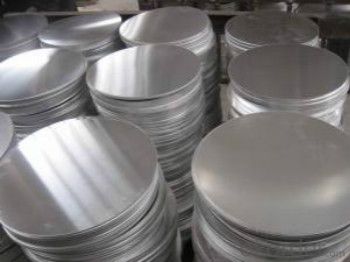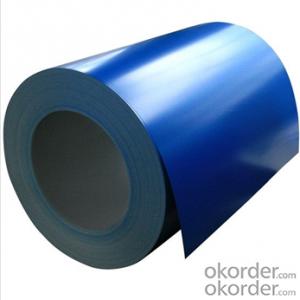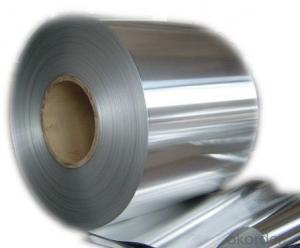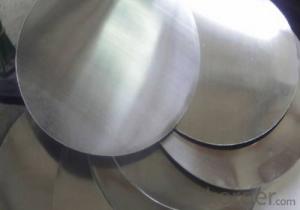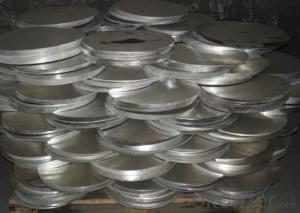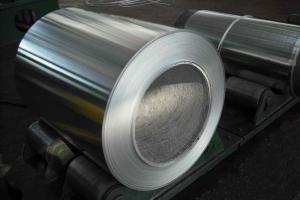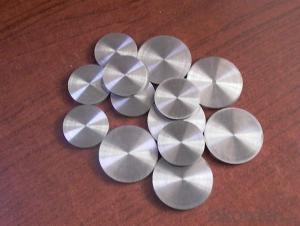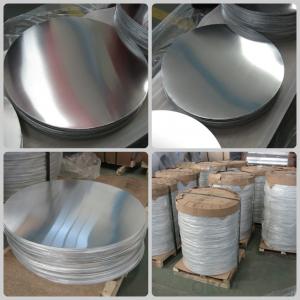5083 Aluminum Coils Wholesale Direct Casting Aluminum Circle for Pot
- Loading Port:
- Shanghai
- Payment Terms:
- TT OR LC
- Min Order Qty:
- 1 m.t.
- Supply Capability:
- 2000 m.t./month
OKorder Service Pledge
OKorder Financial Service
You Might Also Like
Specification
1. Structure of DC Aluminium in Coil Form for making Aluminium Circle Description
CC Aluminium in Coil Form for making Aluminium Circle is one semi-finished aluminium material. This coil can be rolled down to aluminium coil,sheet,circle ect. The alloy AA1050 is widly used in building, industry ect. Its weight is much lower than steel. So many customers choosed aluminium material instead of steel.
2. Feature of DC Aluminium in Coil Form for making Aluminium Circle
Surfact Quality :
Be free from Oil Stain, Dent, Inclusion, Scratches, Stain, Oxide Dicoloration, Breaks, Corrosion, Roll Marks, Dirt Streaks and other defect which will interfere with use,
Mechenical Property:
Chemical Composite and Mechanical Property
3. Image of DC Aluminium in Coil Form for making Aluminium Circle
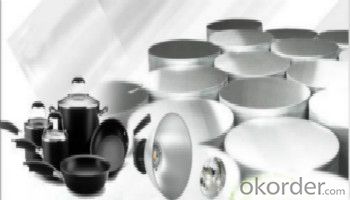
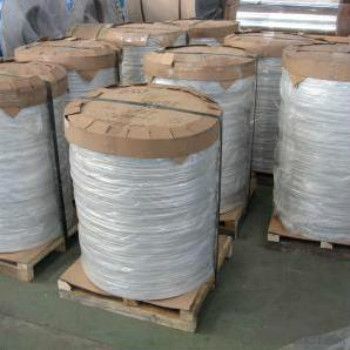
4. Specification of DC Aluminium in Coil Form for making Aluminium Circle
Aluminum Coil/Sheet | |
Main Specification | |
Alloy | AA1xxx (AA1050, AA1060, AA1070, AA1100 etc.) |
AA3xxx (AA3003, AA3004, AA3005, AA3105 etc.) | |
AA5xxx, AA6XXX (AA5052,AA5083, AA5754, AA6061, AA6062 etc.) | |
AA8xxx(AA8011, AA8006 etc.) | |
Temper | H14,H16, H18, H22, H24, H26, H32,O/F, T4, T6, T651 |
Thickmess | 0.01mm-100mm |
Width | 30mm-1700mm |
Standard | GB/T 3880-2006/ASTM |
Special specification is available on customer's requirement | |
5. FAQ
1) What is the delivery time?
Depends on actual order, around 20 to 35 days
2) What is the QC system:
We have QC staff of 20 persons and advanced equipment, each production is with MTC traced from Aluminum ingot lot.
3) What market do you mainly sell to?
Australia, America, Asia, Middle East, Western Europe, Africa etc
4)What about payment term?
30% T/T in advance, balance against B/L COPY.
- Q: What are the typical applications of aluminum coils in the automotive industry?
- Aluminum coils are widely used in the automotive industry for various applications due to their advantageous properties. One typical application is in the manufacturing of automotive heat exchangers, such as radiators and condensers. The high thermal conductivity of aluminum allows for efficient heat transfer, enhancing the cooling efficiency of the vehicle's engine and air conditioning system. Another common use of aluminum coils in the automotive industry is for making lightweight body panels and structural components. Aluminum is known for its low density, which helps reduce the overall weight of the vehicle. This, in turn, improves fuel efficiency and reduces emissions. Additionally, aluminum's high strength-to-weight ratio makes it ideal for impact-absorbing structures, enhancing the safety of the vehicle. Aluminum coils are also utilized in the production of electrical wiring systems and connectors in automobiles. Aluminum's excellent electrical conductivity enables the efficient transmission of electrical signals throughout the vehicle. Furthermore, its corrosion resistance properties make it suitable for use in various weather conditions. Moreover, aluminum coils find application in the production of suspension systems, such as control arms and knuckles. The stiffness and durability of aluminum help enhance the vehicle's handling and responsiveness, resulting in improved driving dynamics. In summary, the typical applications of aluminum coils in the automotive industry include heat exchangers, lightweight body panels, electrical wiring systems, and suspension components. These applications capitalize on aluminum's advantageous properties, such as high thermal conductivity, low density, excellent electrical conductivity, and corrosion resistance.
- Q: Can aluminum coils be fabricated or machined?
- Yes, aluminum coils can be fabricated or machined. Aluminum coils are typically used in applications such as heating, ventilation, and air conditioning (HVAC) systems, automotive radiators, and electrical transformers. These coils can be fabricated or machined to meet specific requirements and dimensions. Fabrication of aluminum coils involves processes such as cutting, bending, and welding to create the desired shape and size. This allows for customization and adaptation to various applications. Machining, on the other hand, involves removing material from the aluminum coil using cutting tools such as lathes, mills, or CNC machines. This process is used to achieve precise dimensions, smooth finishes, and intricate designs. Overall, aluminum coils are versatile and can be fabricated or machined to suit different needs. The flexibility of aluminum as a material makes it a preferred choice for many industries, offering durability, lightweight properties, and excellent thermal conductivity.
- Q: What are the typical lead times for ordering aluminum coils?
- The typical lead times for ordering aluminum coils can vary depending on various factors such as the supplier, quantity ordered, and current market conditions. Generally, lead times can range from a few weeks to several months. For standard or readily available aluminum coil sizes and grades, lead times are usually shorter and can be fulfilled within a few weeks. This is because suppliers often maintain a certain level of inventory for popular products. However, for customized or specialty aluminum coils, lead times tend to be longer. This is because these coils may require specific dimensions, finishes, or alloys that are not readily available. The production process for such coils involves additional steps, such as casting, rolling, and surface treatments, which can extend the lead time. Additionally, market conditions and supplier capacities can also impact lead times. During periods of high demand or when there are supply chain disruptions, lead times for aluminum coils may increase. Conversely, during slower periods or when suppliers have excess capacity, lead times may be shorter. To get an accurate estimate of lead times, it is recommended to contact aluminum coil suppliers directly. They will be able to provide specific information based on their current production schedules and inventory levels.
- Q: What is the role of aluminum coils in HVAC systems?
- The functioning of HVAC systems relies heavily on the presence of aluminum coils, which are vital for system efficiency. Within the air conditioning unit, aluminum coils serve as a crucial component responsible for the transfer of heat between indoor and outdoor environments. When the air conditioning unit operates in cooling mode, the aluminum coils serve as evaporator coils. Their primary function is to absorb heat from the indoor air, resulting in its cooling. The warm air from the room passes over the cold aluminum coils, and the heat is then transferred to the refrigerant flowing through the coils. This process effectively cools the air while removing moisture, ultimately achieving the desired cooling effect. In heating mode, the aluminum coils take on the role of condenser coils. They receive the hot refrigerant from the compressor and proceed to transfer the heat to the surrounding air. This hot air is then circulated throughout the building, providing warmth during colder weather. Aluminum coils are preferred in HVAC systems due to their exceptional heat transfer properties and resistance to corrosion. These coils are lightweight, durable, and possess high thermal conductivity, enabling efficient heat exchange. Additionally, aluminum coils are more environmentally friendly compared to other materials like copper, as they are easier to recycle. Regular maintenance and cleaning of the aluminum coils are essential to ensure optimal performance and prevent any potential airflow restrictions caused by the accumulation of dust, dirt, or debris. Neglecting coil maintenance can result in reduced cooling or heating capacity, decreased energy efficiency, and even system breakdowns. Overall, the significance of aluminum coils in HVAC systems cannot be overstated. These coils play a vital role in facilitating the heat transfer process, enabling efficient temperature control in both cooling and heating modes, and contributing to the overall comfort and functionality of the system.
- Q: How heavy and long is the aluminum rolling on average?
- The blank aluminum coil of aluminum manufacturer is about 5-6 tons, while the aluminum coil of dealer or supplier depends on the feeding frame, about 1.5-2 tons or 3 tons.
- Q: Is it possible to utilize a press machine to bend aluminum coils?
- <p>Yes, you can use a press to bend aluminum coils. Presses are versatile machines capable of bending various materials, including aluminum. However, it's crucial to select the appropriate press type and size for the specific coil dimensions and desired bend. Additionally, ensure the press has the necessary tonnage to handle the bending force required for aluminum. Using the right dies and lubrication can also improve the bending process and prevent damage to the coils. Always follow safety guidelines and consult with equipment specifications to ensure the press is suitable for bending aluminum.</p>
- Q: How do aluminum coils contribute to the aesthetics of architectural designs?
- Aluminum coils contribute to the aesthetics of architectural designs by offering a sleek and modern appearance. They can be used to create clean lines, smooth surfaces, and a polished look, enhancing the overall visual appeal of a building. Additionally, aluminum coils come in a variety of colors and finishes, allowing architects to incorporate them into various design styles and create customized, eye-catching facades.
- Q: Can aluminum coils be used for roofing?
- Certainly, roofing can be done using aluminum coils. Aluminum is widely regarded as a top preference for roofing materials because of its sturdy composition, lightweight properties, and exceptional resistance to corrosion. In a wide range of roofing applications, including residential, commercial, and industrial structures, aluminum roofing coils are frequently employed. They offer exceptional safeguarding against severe weather conditions like intense rainfall, snowfall, and powerful winds. Furthermore, aluminum coils possess energy-efficient attributes as they possess the ability to reflect solar heat, thereby aiding in preserving a cool indoor environment and reducing energy expenditures. All in all, aluminum coils present a dependable and enduring roofing solution.
- Q: Can aluminum coils be used in the production of aluminum cladding?
- Yes, aluminum coils can be used in the production of aluminum cladding.
- Q: Can aluminum coils be used in the manufacturing of aircraft parts?
- Yes, aluminum coils can be used in the manufacturing of aircraft parts. Aluminum is a lightweight and durable material that is widely used in the aerospace industry due to its high strength-to-weight ratio and corrosion resistance. The coils can be formed and machined into various components such as fuselage skins, wings, and structural frames, making them an ideal choice for aircraft manufacturing.
Send your message to us
5083 Aluminum Coils Wholesale Direct Casting Aluminum Circle for Pot
- Loading Port:
- Shanghai
- Payment Terms:
- TT OR LC
- Min Order Qty:
- 1 m.t.
- Supply Capability:
- 2000 m.t./month
OKorder Service Pledge
OKorder Financial Service
Similar products
Hot products
Hot Searches
Related keywords



